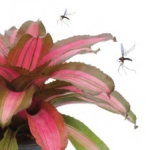Beautiful Bromeliads
by Patrick Linn, MS, MSHAPI
Executive Director, Collier Mosquito Control District
Southwest Florida residents love the variety and color that bromeliads add to homes and landscapes. Did you know
mosquitoes love bromeliads, too? The plant’s center tank and each leaf base hold water that presents a very safe and appealing habitat for them to lay their eggs. Not to worry, though; with a few simple steps, you can enjoy a bromeliad filled landscape while not playing host to biting mosquitoes.
 I wish to share a brief story to illustrate the potential problem the plants may present. A few years ago, one of our Field Technicians responded to a resident’s request to determine where her mosquito problem was originating. Our general surveillance of the area indicated there weren’t high numbers of mosquitoes, but this unfortunate lady reported that each day when she retrieved her mail, she was attacked by clouds of mosquitoes. This piqued our curiosity and we suspected there was an isolated area breeding the biters.
I wish to share a brief story to illustrate the potential problem the plants may present. A few years ago, one of our Field Technicians responded to a resident’s request to determine where her mosquito problem was originating. Our general surveillance of the area indicated there weren’t high numbers of mosquitoes, but this unfortunate lady reported that each day when she retrieved her mail, she was attacked by clouds of mosquitoes. This piqued our curiosity and we suspected there was an isolated area breeding the biters.
When our Field Technician arrived, he immediately noted that both sides of her driveway were lined with gorgeous bromeliads. Upon closer inspection, he found that each plant was teeming with thousands of mosquito larvae in the small pockets of water held by the bromeliad. In short, the resident was unknowingly in possession of a very productive mosquito farm. Further, one species of mosquito that favors breeding in bromeliads has a very short flight range; approximately 100 meters. Thus, the problem was hyper-localized to this individual’s yard.
Was this resident forced to remove the bromeliads after the findings presented? No, because the Collier Mosquito Control District was happy to share some simple solutions that allow residents to continue to enjoy the beauty these plants bring to local landscapes. Importantly, these steps not only help to prevent mosquito bites; they actually help to
prevent disease. Of the mosquito species that favor breeding in bromeliads, a few can transmit diseases such as Zika, dengue, chikungunya, yellow fever, and West Nile Virus.
The District offers these three steps to prevent mosquitoes from breeding in bromeliads:
1. Sprinkle some safe larvicide into the water found in the bromeliad’s center tank and leaves. One of the most popular choices is granular Bti (Bacillus thuringiensis isrealensis), a biological bacterium that targets only mosquito larvae and
black fly larvae. When used as directed, it is safe for use with plants, people and pets. One popular brand found locally at hardware and home improvement stores is Mosquito Bits®.
2. Flush the water out of the bromeliad’s tanks and leaves weekly, preferably with a water hose. The purpose of flushing the bromeliad is to wash away mosquito eggs and larvae that might be in the plant’s standing water. Try to flush the old water onto a dry spot where any larvae will dry out and die. Because it only takes about seven days for mosquito eggs to become full-fledged adults, flushing the plant weekly will eliminate the potential for increased mosquito populations.
3. Coat the bromeliad’s standing water with a small amount of food grade oil. The layer of oil lowers the surface tension of the water, making it difficult for a mosquito to lay her eggs there. It also creates a barrier that suffocates any larvae
already in the water.

Need to schedule a Field Technician visit for your property? Please use the form on our website (www.cmcd.org) or call our office at (239) 436-1000.




Leave a Reply
Want to join the discussion?Feel free to contribute!